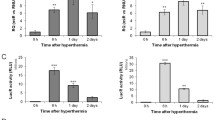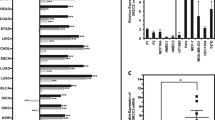Abstract
Purpose
Promoters developed for radiogene therapy always show non-negligible transcriptional activities, even when cells are not irradiated. This study developed a tightly radiation-controlled molecular switch based on radiation responsive element (CArG) repeats for in vivo molecular imaging using the Cre/loxP system.
Procedures
Different numbers of CArG repeats were cloned as a basal promoter directly, and its pre- and postirradiation transcriptional activities were analyzed by luciferase assay. Nine CArG repeats (E9) were chosen for use as a radiation-controlled molecular switch for the Cre/loxP system, and the feasibility of the switch in vitro and in vivo was demonstrated by luciferase assay and bioluminescence imaging, respectively.
Results
The E9 promoter, which exhibits extremely low transcriptional activity, showed a 1.8-fold enhancement after irradiation with a clinical dose of 2 Gy. Both in vitro and in vivo results indicated that E9 is relatively inert but sufficient to trigger the Cre/loxP system. The luciferase activity of stable H1299/pSTOP-FLuc cells transfected with pE9-NLSCre and exposed to 2-Gy radiation can reach 44 % of that of the same cells transfected with pCMV-NLSCre and not subjected to irradiation. By contrast, no appreciable difference was observed in reporter gene expression in both H1299/pSTOPFluc cells and tumors transfected with pE4Pcmv-NLSCre before and after irradiation, because the strong basal transcriptional activity of the CMV promoter, which acts as a copartner of E4, masked the response of E4 to radiation.
Conclusions
Our results provide detailed insight into CArG elements as a radiation-controlled molecular switch that can facilitate the development of radiogene therapy.




Similar content being viewed by others
References
Hellman S (2001) Principles of cancer management: radiation therapy. In: DeVita Jr VT, Hellman S, Rosenberg SA (eds) Cancer: principlesand practice of oncology, 6th edn. Lippincott Williams & Wilkins, Philadelphia, pp 265–288
Mundt AJ, Roeske JC, Chung TD, Weichselbaum RR (2003) Principles of radiation oncology. In: Kufe DW, Pollock RE, Weichselbaum RR, et al. (eds) Holland–Frei cancer medicine, 6th edn. BC Decker, Hamilton, pp 585–604
Provencio M, Sanchez A, Garrido P, Valcarcel F (2010) New molecular targeted therapies integrated with radiation therapy in lung cancer. Clin Lung Cancer 11:91–97
Kufe D, Weichselbaum R (2003) Radiation therapy: activation for gene transcription and the development of genetic radiotherapy-therapeutic strategies in oncology. Cancer Biol Ther 2:326–329
Valerie K, Yacoub A, Hagan MP et al (2007) Radiation-induced cell signaling: inside-out and outside-in. Mol Cancer Ther 6:789–801
Gottesman MM (2003) Cancer gene therapy: an awkward adolescence. Cancer Gene Ther 10:501–508
Danda R, Krishnan G, Ganapathy K et al (2013) Targeted expression of suicide gene by tissue-specific promoter and microRNA regulation for cancer gene therapy. PLoS One 8:e83398
Wang HW, Breslin MB, Chen C et al (2009) INSM1 promoter-driven adenoviral herpes simplex virus thymidine kinase cancer gene therapy for the treatment of primitive neuroectodermal tumors. Hum Gene Ther 20:1308–1318
Hsieh YJ, Chen FD, Ke CC et al (2012) The EIIAPA chimeric promoter for tumor specific gene therapy of hepatoma. Mol Imaging Biol 14:452–461
Robson T, Worthington J, McKeown SR, Hirst DG (2005) Radiogenic therapy: novel approaches for enhancing tumor radiosensitivity. Technol Cancer Res Treat 4:343–361
Rodningen OK, Overgaard J, Alsner J et al (2005) Microarray analysis of the transcriptional response to single or multiple doses of ionizing radiation in human subcutaneous fibroblasts. Radiother Oncol 77:231–240
Snyder AR, Morgan WF (2004) Gene expression profiling after irradiation: clues to understanding acute and persistent responses? Cancer Metastasis Rev 23:259–268
Rodemann HP, Dittmann K, Toulany M (2007) Radiation-induced EGFR-signaling and control of DNA-damage repair. Int J Radiat Biol 83:781–791
Dittmann K, Mayer C, Kehlbach R, Rodemann HP (2008) Radiation-induced caveolin-1 associated EGFR internalization is linked with nuclear EGFR transport and activation of DNA-PK. Mol Cancer. doi:10.1186/1476-4598-7-69
Shore P, Sharrocks AD (1994) The transcription factors Elk-1 and serum response factor interact by direct protein-protein contacts mediated by a short region of Elk-1. Mol Cell Biol 14:3283–3291
Murai K, Treisman R (2002) Interaction of serum response factor (SRF) with the Elk-1 B box inhibits RhoA-actin signaling to SRF and potentiates transcriptional activation by Elk-1. Mol Cell Biol 22:7083–7092
Osborn L, Kunkel S, Nabel GJ (1989) Tumor necrosis factor alpha and interleukin 1 stimulate the human immunodeficiency virus enhancer by activation of the nuclear factor kappa B. Proc Natl Acad Sci U S A 86:2336–2340
Weichselbaum RR, Hallahan D, Fuks Z, Kufe D (1994) Radiation induction of immediate early genes: effectors of the radiation-stress response. Int J Radiat Oncol Biol Phys 30:229–234
Janknecht R (1995) Regulation of the c-fos promoter. Immunobiology 193:137–142
Ahmed MM (2004) Regulation of radiation-induced apoptosis by early growth response-1 gene in solid tumors. Curr Cancer Drug Targets 4:43–52
Datta R, Taneja N, Sukhatme VP et al (1993) Reactive oxygen intermediates target CC(a/T)6GG sequences to mediate activation of the early growth response 1 transcription factor gene by ionizing radiation. Proc Natl Acad Sci U S A 90:2419–2422
Joki T, Nakamura M, Ohno T (1995) Activation of the radiosensitive EGR-1 promoter induces expression of the herpes simplex virus thymidine kinase gene and sensitivity of human glioma cells to ganciclovir. Hum Gene Ther 6:1507–1513
Scott SD, Marples B, Hendry JH et al (2000) A radiation-controlled molecular switch for use in gene therapy of cancer. Gene Ther 7:1121–1125
Scott SD, Joiner MC, Marples B (2002) Optimizing radiation-responsive gene promoters for radiogenetic cancer therapy. Gene Ther 9:1396–1402
Coulter JA, McCarthy HO, Worthington J et al (2008) The radiation-inducible pE9 promoter driving inducible nitric oxide synthase radiosensitizes hypoxic tumour cells to radiation. Gene Ther 15:495–503
Sambucetti LC, Cherrington JM, Wilkinson GW, Mocarski ES (1989) NF-kappa B activation of the cytomegalovirus enhancer is mediated by a viral transactivator and by T cell stimulation. EMBO J 8:4251–4258
Chen J, Stinski MF (2002) Role of regulatory elements and the MAPK/ERK or p38 MAPK pathways for activation of human cytomegalovirus gene expression. J Virol 76:4873–4885
Iyer M, Wu L, Carey M et al (2001) Two-step transcriptional amplification as a method for imaging reporter gene expression using weak promoters. Proc Natl Acad Sci U S A 98:14595–14600
Karpati G, Lochmüller H (1997) The scope of gene therapy in humans: scientific, safety and ethical considerations. Neuromuscul Disord 7:273–276
Wang Z, Sun Y (2010) Targeting p53 for novel anticancer therapy. Transl Oncol 3:1–12
Vichalkovski A, Gresko E, Hess D et al (2010) PKB/AKT phosphorylation of the transcription factor Twist-1 at Ser42 inhibits p53 activity in response to DNA damage. Oncogene 29:3554–3565
Valsesia-Wittmann S, Magdeleine M, Dupasquier S et al (2004) Oncogenic cooperation between H-Twist and N-Myc overrides failsafe programs in cancer cells. Cancer Cell 6:625–630
Giaccia AJ, Kastan MB (1998) The complexity of p53 modulation: emerging patterns from divergent signals. Genes Dev 12:2973–2983
Ko LJ, Prives C (1996) p53: puzzle and paradigm. Genes Dev 10:1054–1072
McCarthy HO, Worthington J, Barrett E et al (2007) p21((WAF1))-mediated transcriptional targeting of inducible nitric oxide synthase gene therapy sensitizes tumours to fractionated radiotherapy. Gene Ther 14:246–255
Chastel C, Jiricny J, Jaussi R (2004) Activation of stress-responsive promoters by ionizing radiation for deployment in targeted gene therapy. DNA Repair (Amst) 3:201–215
Sherman ML, Datta R, Hallahan DE et al (1990) Ionizing radiation regulates expression of the c-jun protooncogene. Proc Natl Acad Sci U S A 87:5663–5666
Das A, Chendil D, Dey S et al (2001) Ionizing radiation down-regulates p53 protein in primary Egr-1−/− mouse embryonic fibroblast cells causing enhanced resistance to apoptosis. J Biol Chem 276:3279–3286
Hsieh YJ, Liu RS, Hwu L et al (2007) Cre/loxP system controlled by specific promoter for radiation-mediated gene therapy of hepatoma. Anticancer Res 27:1571–1579
Caposio P, Luganini A, Bronzini M et al (2010) The Elk-1 and serum response factor binding sites in the major immediate-early promoter of human cytomegalovirus are required for efficient viral replication in quiescent cells and compensate for inactivation of the NF-kappaB sites in proliferating cells. J Virol 84:4481–4493
Silver DP, Livingston DM (2001) Self-excising retroviral vectors encoding the Cre recombinase overcome Cre-mediated cellular toxicity. Mol Cell 8:233–243
Semprini S, Troup TJ, Kotelevtseva N et al (2007) Cryptic loxP sites in mammalian genomes: genome-wide distribution and relevance for the efficiency of BAC/PAC recombineering techniques. Nucleic Acids Res 35:1402–1410
Thyagarajan B, Guimarães MJ, Groth AC, Calos MP (2000) Mammalian genomes contain active recombinase recognition sites. Gene 244:47–54
Loonstra A, Vooijs M, Beverloo HB et al (2001) Growth inhibition and DNA damage induced by Cre recombinase in mammalian cells. Proc Natl Acad Sci U S A 98:9209–9214
Jeannotte L, Aubin J, Bourque S et al (2011) Unsuspected effects of a lung-specific Cre deleter mouse line. Genesis 49:152–159
Acknowledgments
This research was supported by the grants: NSC 102-2314-B-010-038-MY3, NSC 102-2627-M-010-003 (National Science Council, Taiwan), MOST 103-2314-B-037-007 (Ministry of Science and Technology), MOHW104-TDU-B-211-124-001 (Department of Health), and V103C-132 (Taipei Veterans General Hospital). The authors thank the technical support from Molecular and Genetic Imaging Core, Taiwan Mouse Clinic (MOST 103-2325-B-001-015), which is funded by the National Research Program for Biopharmaceuticals (NRPB) at the Ministry of Science and Technology (MOST) of Taiwan, and Ms. Tsuey-Ling Jan for the assistance of preparing the manuscript.
Conflict of Interest
The authors declare that they have no conflict of interest.
Author information
Authors and Affiliations
Corresponding author
Rights and permissions
About this article
Cite this article
Hsieh, YJ., Hwu, L., Ke, CC. et al. Demonstration of Tightly Radiation-Controlled Molecular Switch Based on CArG Repeats by In Vivo Molecular Imaging. Mol Imaging Biol 17, 802–810 (2015). https://doi.org/10.1007/s11307-015-0843-7
Published:
Issue Date:
DOI: https://doi.org/10.1007/s11307-015-0843-7




